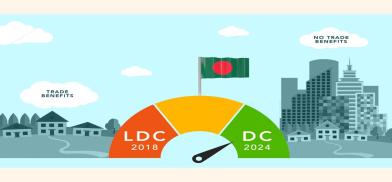Why does Pakistan lag far behind Bangladesh?
Although Bangladesh was a part of Pakistan, it has already surpassed Pakistan in almost all socio-cultural and economic indicators, writes Jebeda Chowdhury for South Asia Monitor

As it celebrated its 50th founding anniversary, Bangladesh’s tremendous economic growth and achievements were being discussed globally. But when it was born in 1971, Bangladesh inherited a fragile economy. Henry Kissinger, the then US Secretary of State, called Bangladesh a “bottomless basket”. On the other hand, in 1976, Norwegian economist Just Faland and American economist J.R. Parkinson published a book which said: “Bangladesh is a testing ground for development. If Bangladesh can solve its development problems, then it must be understood that any country can improve.”
Prime Minister Sheikh Hasina has achieved the feat of moving Bangladesh’s status from a least developed country to a developing country. Even before the 50th anniversary of independence, Bangladesh had come a long way compared to Pakistan.
In the seventies, independent Bangladesh was recognized as a place plagued by food shortage, famine and natural disasters. In half a century, Bangladesh has overcome many negative images.
Pakistani praise
Abid Hassan, a former adviser to the World Bank and a Pakistani economist, recently praised Bangladesh’s economic potential. He said that even 20 years ago, it was unthinkable that Bangladesh’s per capita income would double in 2020. If Bangladesh’s current progress continues, it will become an economic powerhouse by 2030.
He further wrote that if the current situation in Pakistan does not change, it may become necessary for Pakistan to seek financial help from Bangladesh by 2030.
In the seventies, independent Bangladesh was recognized by the world as a place plagued by food shortage, famine, and natural disasters. Now, Bangladesh has surpassed not only Pakistan but also India in several human indicators. Various international organizations including the World Bank, World Economic Forum and Economic Intelligence Unit have identified Bangladesh’s economic development as a “wonderful puzzle”.
From 2011 to 2019, Bangladesh’s exports have increased at a rate of 8.6 percent per annum as compared to 0.4 percent in the world. GDP per capita has risen to Rs. 2,554, compared to Pakistan’s Rs. 1,543. The current economy of Bangladesh is much bigger than Pakistan’s.
Asian tiger?
Some megaprojects are being implemented in Bangladesh. These projects helped Bangladesh to revive its economy during the Covid-19 pandemic. Nobel laureate and economist Amartya Sen cited Bangladesh as an example when it comes to the development model. During a visit to Bangladesh last year, Kaushik Basu, then Senior Vice President and Chief Economist at the World Bank, said: “It would not be an exaggeration to say that Bangladesh will soon emerge as the new tiger of Asia.”
Although Bangladesh was a part of Pakistan, it has already surpassed Pakistan in almost all socio-cultural and economic indicators.
The main reason for this progress is that in the last 10 years Bangladesh has achieved an average growth rate of 7 percent and has been ranked as the fastest-growing country.
In addition, the population is an increasing problem in Pakistan. While the population of Pakistan was 10 million less than in Bangladesh in 1971, it is now about 40 million more. The population growth rate of Bangladesh is 1.2 percent and in Pakistan, it is 2.1 percent, which is almost double.
Why Pakistan lags?
On the other hand, Pakistan has lagged behind due to social conditions. All property is in the hands of a small number of people. It goes without saying that women do not have rights in that country. Bangladesh ranks 50th out of 156 countries in the Gender Parity Index, while Pakistan ranks 153rd. In other words, it has fallen to the bottom.
According to the International Labour Organization’s 2019 data, the participation rate of women in the workplace in Bangladesh is 38 percent; it is 23 percent in Pakistan.
When Imran Khan came to power in Pakistan and announced that he wanted to transform Pakistan into a Sweden in five years, Jaigham Khan, a development activist, published an article titled “The Bangladesh Model”. He suggested that Pakistan should become a Bangladesh first instead of trying to be a Sweden. Even to become a Bangladesh would take ten years for Pakistan, he argued.
Ironically, the people of Pakistan now think that a country that was separated from them after a long and bloody war of nine months is a role model. This is enough to show how far Bangladesh has come.
(The writer, a teacher, did her Master's in International Relations from the University of Dhaka, Bangladesh. The views expressed are personal. She can be reached at jubedachowdhury103@gmail.com)









Post a Comment